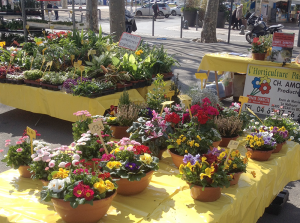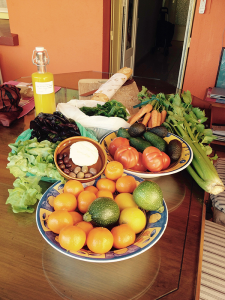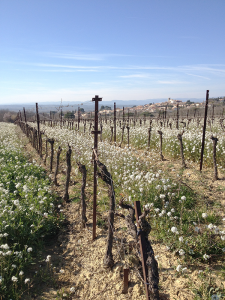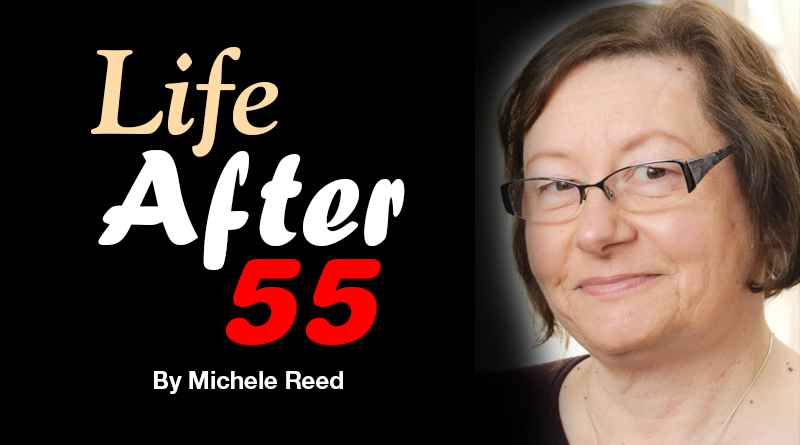Fresh Veggies, Flowers and Sun: Winter in France
By Michele Reed
michele@cny55.com

Our French neighbors don’t understand why these crazy Americans come every January, and not the “beautiful month of April,” as they always recommend. At those moments, I raise my hand waist high and tell them we have “snow by the meter.” I can’t wait to see their faces when I show them pictures of Bill cleaning off the car on Dec. 27. That day’s snowfall in Oswego — 39 inches — is exactly one meter, and it fell during only a six-hour period!
Because they are used to it, the French don’t see how much more pleasant their winter weather is. One sunny, 63-degree day last February at the weekly outdoor flower market in Beziers, I purchased two small plants, a cyclamen and primrose, both in full bloom, for a total of $4. They spent the winter on our windowsill — outside!
Not only are flowers plentiful, our farmers’ markets are full of fresh produce from France and nearby Spain. At that same day’s market I picked up a perfect head of lettuce, ripe tomatoes, fresh young onions, a leek, leafy celery and a firm white cauliflower for a grand total of $6.
Paradise for a Central New Yorker! But it’s not always like that. It’s still winter in the south of France, and while it in no way compares to snowy Upstate New York, it can sometimes be cold and windy, with plenty of rain to chill these old bones.
When we arrive in mid-January, temperatures can be as low as the high 30s or low 40s with strong winds. Our stone house starts out frigid. In our absence, September to January, the house has plenty of time to get really chilly. Foot-thick stone walls and terracotta floors hold the cold and they don’t like to give it up easily. There is no central heating, which is common practice there. We have two electric heaters in the living room (although we’ve only ever needed to use one), one in the hall between the bedroom and bathroom, and one in the top-floor guest room.

For the first two or three days, we go around the house with layers of sweaters on and scarves around our necks. Little by little, as the house warms up, we shed the layers, and eventually after a week or two, we even keep the heaters off most of the winter. There is no window in the bathroom but as is common in Europe, there is a nine-inch diameter screened vent drilled through the thick stone wall, bringing light and air into the room. On warm days you can hear the doves and chickens our neighbor raises right in the heart of the village, cooing and clucking in an avian chorale. The vent is right above the shower and in winter, cold air pours in. When the wind is just right, you can see your breath. Our first couple of weeks in France every winter are marked by very quick showers.
Our house is not the only “stone cold” place, as Bill has dubbed it. Churches, like in the United States, are kept closed when there are no services. So during the week, the stone walls of the church get very cold. In our little village, because of the priest shortage, we only have mass once a month. The church, first built in the 1200s and added to over the centuries, is a massive stone structure — originally the village’s defense, complete with arrow slits — perched high on a hill overlooking the plains and rolling vineyards. There is a direct line from the Montagnes Noires, or Black Mountains, the edge of France’s Massif Central. The cold tramontane winds (their name means, literally, “over the mountains”) have nothing to stop them as they buffet the church. So our village church is cold in winter, but we prefer it to our other options. At least we have infrared heaters on high pillars aiming down upon the congregation. It makes it so warm within their reach, that we sometimes have to shed our scarves and coats.
Not so on the other three weekends of the month. We take the bus into the nearby city of Beziers to an 11th century church made famous by the Crusaders’ slaughter of 7,000 people, according to medieval chronicles. When the Crusaders fighting the Cathar heretics in 1209 asked the papal legate how they should know which people hiding in the church were the heretics to slay and which were innocent Christians, he famously said, “Kill them all. God will know His own.”
But that chilling story is nothing compared to the chill we feel when we walk into the Church of St. Mary Magdalene every winter weekend. Because the church is closed all week, not only is it frigid inside, it is damp and musty to boot. It can be 60 degrees outside on an early spring day, and be a bone-chilling 40 inside. We dress in coats with down vests underneath, scarves and wool gloves, right through mass. The saving grace is that in France, unlike in the States, there are no kneelers. So congregants stand for most of the service. Being saved from kneeling on the stone floor and able to move around a little help to keep us warm. The opposite is true in summer, when the stone church — with no windows that can open — becomes an oven, with temperatures rising to the high 90s or even 100.

Our area is very near Spain, and we keep many of their customs so it is common to see ladies fanning themselves with ornate Spanish fans throughout summer services.
The cold weather ends quickly, and daytime temps between February and April rise steadily through the 50s, 60s and 70s. The mimosas are in full bloom by Valentine’s Day, and families take walks in shirtsleeves to pick the fragrant yellow flowers growing wild by the roadside to greet the arrival of spring. By the time we leave France in April, the temperatures are hitting 70. With 320 days of sunshine year, even in depth of winter, we enjoy the feeling of well-being a blue sky and natural sunlight bring.
Weather is a constant topic of conversation, and on a sunny day, even the natives remark on the “beau soleil,” or beautiful sun, and smiles are everywhere. Fresh flowers and produce, beautiful sunshine and mild temperatures — that’s why we became “snow birds” who fly all the way across the Atlantic to our winter home.
Michele Reed retired after a career spanning four decades in public relations, advertising, journalism and higher education. She now writes travel articles, book reviews, haiku poetry and fiction. Bill Reed retired after four decades in social services with the county of Oswego, and now works at travel photography and photojournalism, along with writing book reviews.

